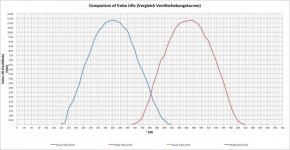Lutz Kramer
Jedi Hopeful
Offline
Last week I started a thread with the headline "Ignition timing with Pertronix Ignitor and strobe light" (https://www.britishcarforum.com/bcf...iming-with-Pertronix-Ignitor-and-strobe-light) since I thought the phenomenon with my car was corresponding to these issues. With the help of some experienced forum members I found out that this was not the case. So I started this thread to draw the attention to the more likely reasons.
When I checked the ignition timing of my AH 3000 BJ8 with a strobe light I found it was set at 45° BTDC at idle and about 65° at about 4500 rpm. Nevertheless the car is performing excellant! It's running perfectly at idle as well as at high rpm. I hear you say:Then leave it as it is and don't touch it. Yes, you're right and I dont't really want to touch it, but I would like to know what is going on here.
Whenever I change the timing towards the standard setting of 15° BTDC at idle the engine stalls.
I really checked everything:
- changed the strobe light
- did a static timing
- took out the Pertronix and put in the old Mallory twin contact distributor
- checked the TDC mark on the pulley with position of #1 piston
- checked the timing between camshaft and crankshaft and so on.
Everything was OK!
When I was ckecking the timing between the camshaft and crankshaft I took alle the data of the valve lifts at all positions of the crank, I mean every 10°. All of a sudden I realised that there must be a hot cam in the engine which I didn't know. The data I found tell me it's a 290° or 288° camshaft.

So my questions are:
Does a hot or racing camshaft require an advanved ignition and if so, how far should the igniton be moved to "early" for a BJ8.
And what about my setting of 45° BTDC at idle? Don't you agree, that this setting cannot work even with the cam I have? But if so, what is the reason for my car still performing so well?
May be there are some specialists out there who are experienced with hot cams and racing cars and know what is going on here?
Best regards from Germany
Lutz
When I checked the ignition timing of my AH 3000 BJ8 with a strobe light I found it was set at 45° BTDC at idle and about 65° at about 4500 rpm. Nevertheless the car is performing excellant! It's running perfectly at idle as well as at high rpm. I hear you say:Then leave it as it is and don't touch it. Yes, you're right and I dont't really want to touch it, but I would like to know what is going on here.
Whenever I change the timing towards the standard setting of 15° BTDC at idle the engine stalls.
I really checked everything:
- changed the strobe light
- did a static timing
- took out the Pertronix and put in the old Mallory twin contact distributor
- checked the TDC mark on the pulley with position of #1 piston
- checked the timing between camshaft and crankshaft and so on.
Everything was OK!
When I was ckecking the timing between the camshaft and crankshaft I took alle the data of the valve lifts at all positions of the crank, I mean every 10°. All of a sudden I realised that there must be a hot cam in the engine which I didn't know. The data I found tell me it's a 290° or 288° camshaft.

So my questions are:
Does a hot or racing camshaft require an advanved ignition and if so, how far should the igniton be moved to "early" for a BJ8.
And what about my setting of 45° BTDC at idle? Don't you agree, that this setting cannot work even with the cam I have? But if so, what is the reason for my car still performing so well?
May be there are some specialists out there who are experienced with hot cams and racing cars and know what is going on here?
Best regards from Germany
Lutz

 Hey there Guest!
Hey there Guest!
 smilie in place of the real @
smilie in place of the real @
 Pretty Please - add it to our Events forum(s) and add to the calendar! >>
Pretty Please - add it to our Events forum(s) and add to the calendar! >> 


 A friendly reminder - be careful what links you click on here. If a link is posted by someone you don't know, or the URL looks fishy, DON'T CLICK. Spammers sometimes post links that lead to sites that can infect your computer, so be mindful what you click.
A friendly reminder - be careful what links you click on here. If a link is posted by someone you don't know, or the URL looks fishy, DON'T CLICK. Spammers sometimes post links that lead to sites that can infect your computer, so be mindful what you click.